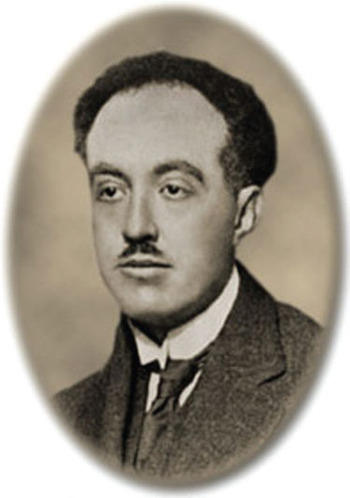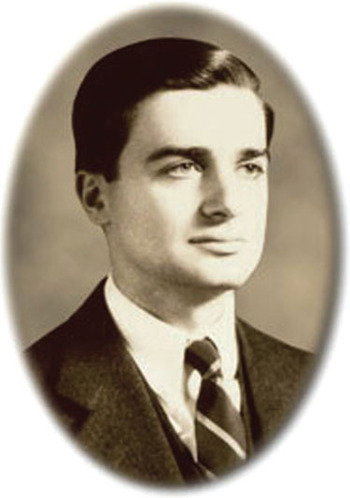
Louis de Broglie (1892–1987)
In the early twentieth century, the long standing argument about whether the character of light was particle-based or wavelike was finally coming to an end as the scientists of the day began to accept that light could assume a dual nature. The possibility that such a duality might apply to matter as well as light was first proposed by physicist Louis de Broglie. Born in Dieppe, France, de Broglie studied in Paris and was descended from members of the French nobility. In his youth, he considered a career as a diplomat but later turned to science and pursued the study of theoretical physics. His brother, Maurice, who had also decided to become a physicist and made many advances in the study of X rays, reportedly had a considerable influence on de Broglie and was the first to introduce him to the work of Albert Einstein and Max Planck.

Louis de Broglie received a science degree in 1913 but was soon after required to enter the military. During World War I, he was stationed at the Eiffel Tower as part of the wireless telegraphy army subdivision. When not occupied by official duties, de Broglie filled many of his hours pondering scientific questions, which helped prepare him to continue his studies in 1920 after the war had ended. The focus of his research upon his return to Paris shifted to mathematical physics, and his doctoral thesis consisted of research on quantum theory. Within de Broglie's thesis, which was completed in 1924, many of his most profound ideas were put forth, including his groundbreaking theory of electron waves. He had published some work on electron waves in scientific journals previously as well, but the articles were given little notice. It was not until Einstein read a copy of de Broglie's thesis that the revolutionary nature of his ideas was understood. Due to Einstein's attention, other physicists became familiar with de Broglie's wave theory and used it in shaping their own work. Most notably, de Broglie's theory served as the foundation upon which Erwin Schrödinger and others developed quantum mechanics.
Although there was at first no experimental data to support de Broglie's theory that electrons behave like waves (in addition to behaving like particles, or quanta), the theory did help explain many previously unaccountable phenomena. For example, experimental evidence had shown that electrons must move around the nucleus of an atom and that certain restrictions are placed on this motion. De Broglie's consideration of the electron as a wave suggested a plausible explanation for this restricted motion. In a closed loop (like that traditionally associated with an electron moving around a nucleus), the undulations of a wave must stretch evenly around the entirety of the loop and consist of a whole number of wavelengths. If they do not, then the wave is cancelled. These conditions on a closed-loop wave are consistent with the evidence that an electron in an atom has only available to it a select set of configurations. Also, the de Broglie view of electrons can be used to rationalize how subatomic particles can materialize in locations one would not traditionally expect to find them, because the waves are thought to be able to travel through obstacles.
A few years after de Broglie's theory was published, in 1927, it was experimentally demonstrated by American physicists Clinton Davisson and Lester Germer that electrons do exhibit wavelike characteristics through their observation of the diffraction of electrons from the surface of a solid crystal. Additional support for the wavelike behavior of electrons was provided around the same time by British scientist George Paget Thomson, and soon after Otto Stern, a German physicist, carried out experiments on helium atoms and hydrogen molecules that supported de Broglie's additional claim that complex particles, not just electrons, also exhibit properties similar to waves. With such experimental evidence to support it, de Broglie's particle-wave duality theory of matter gained widespread acceptance and garnered its creator the Nobel Prize for physics in 1929.
During the rest of his long and illustrious career, de Broglie worked on various aspects of wave mechanics and published a large number of scientific treatises. He also taught theoretical physics at the Sorbonne in Paris and composed several books exploring the relationship between physics and philosophy. In addition to the Nobel Prize, de Broglie received a large number of other honors, including a number of honorary doctorate degrees, an appointment as an adviser to the French Atomic Energy Commissariat, and election into the French Academy of Sciences and the British Royal Society. He was also bestowed the 1952 Kalinga Prize by the United Nations Economic and Social Council as well as the gold medal of the French National Scientific Research Centre (1956).
Edwin Herbert Land (1909–1991)
The founder of the Polaroid Corporation, Edwin Herbert Land was an American inventor and researcher who dedicated his entire adult life to the study of polarized light, photography, and color vision. The son of a Connecticut scrap metal dealer, Land was educated at the Norwich Free Academy and, as a child, slept with a copy of Robert Wood's Physical Optics under his pillow.

As a Harvard University freshman studying physics, Land sought a way to produce an inexpensive and efficient polarizer. His impetus for the endeavor was the lack of safety for nighttime pedestrians who were hit by cars because of the glare from headlights of oncoming vehicles. He soon abandoned his formal education in favor of self-directed study at the New York Public Library. Land succeeded in his quest and developed a new kind of polarizer, which he called Polaroid, in which iodoquinine sulfate crystals were aligned and embedded in a transparent plastic sheet that prevented the crystals from drifting apart. The new polarizer film, which was low-cost, thin, and could be cut easily to any size and shape to fit the application, was patented in 1929. Land returned to Harvard for a time to perfect his polarizer but never graduated, although he was eventually given an honorary degree.
With his Harvard physics instructor, George Wheelwright III, Land left school for the second time to found the Land-Wheelwright Laboratories in 1932. Together they learned to make reliable, cheap polarizers and sell them for camera filters and sunglasses, and they persuaded investors of the huge potential market for polarizers to control headlight glare and view three-dimensional movies. In 1937, with the help of investors, the enterprise became Polaroid Corporation, of which Land was both president and head of research.
The Polaroid organization was to become incredibly successful in a variety of areas. The research team was especially important for domestic defense and other military purposes. One important Polaroid design was the vectograph, which created three-dimensional images by superimposing two views of a stereoscopic picture on a single sheet of film, and is still used in aerial photography and satellite reconnaissance. Land also helped develop infrared polarizers, heat-stable filters, night-vision goggles, polarizing ring sights, and a special lens that was outfitted on the infamous U-2 spy planes. For his national security work, Land received the W.O. Baker Award, the Presidential Medal of Freedom, and the National Medal of Science.
Perhaps Land's most famous contribution to science, however, was his development of instant photography. The invention was inspired by his three-year-old daughter when she asked him why she could not instantly see a picture he had just taken of her on vacation. The one-step dry photographic process took Land three years to perfect, but his success was phenomenal. Geared toward the growing, post-war middle class, his instant cameras marketed for under $100, did not require much skill to use, and became hugely popular. Later, with scientists in mind, Land created instant cameras for use with microscopes, telescopes, and oscilloscopes.
A lifelong interest in human color vision spurred over thirty years of Land's research. Working with various academics, he helped explain the link between vision and neurophysiology in his retinex theory and was one of the first to propose that color was a field, instead of a point, phenomenon. Land was extremely driven and inquisitive and completed numerous experiments during his studies. When Land retired as Polaroid's president in 1982, he did not rest; he founded the Rowland Institute for Science.


